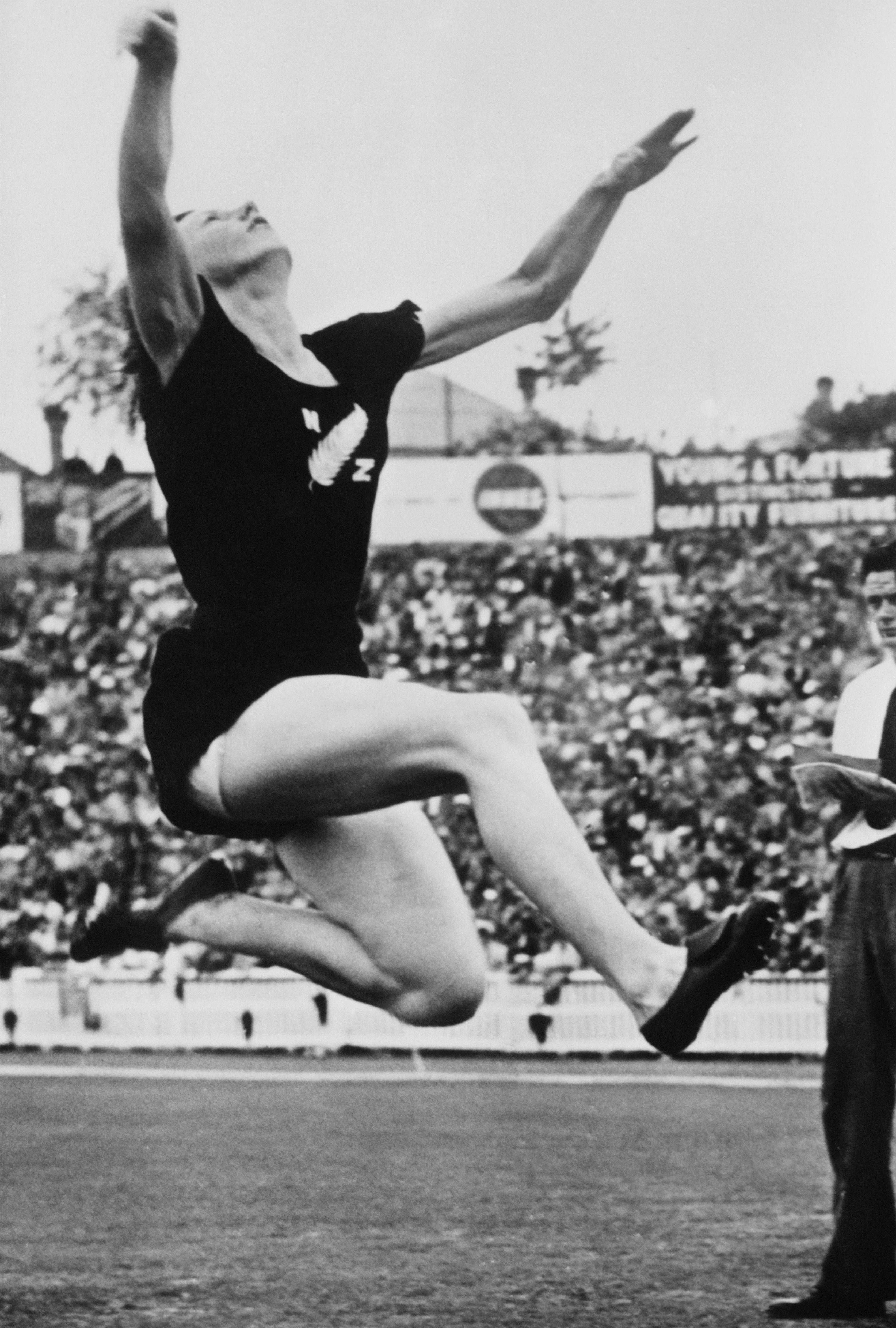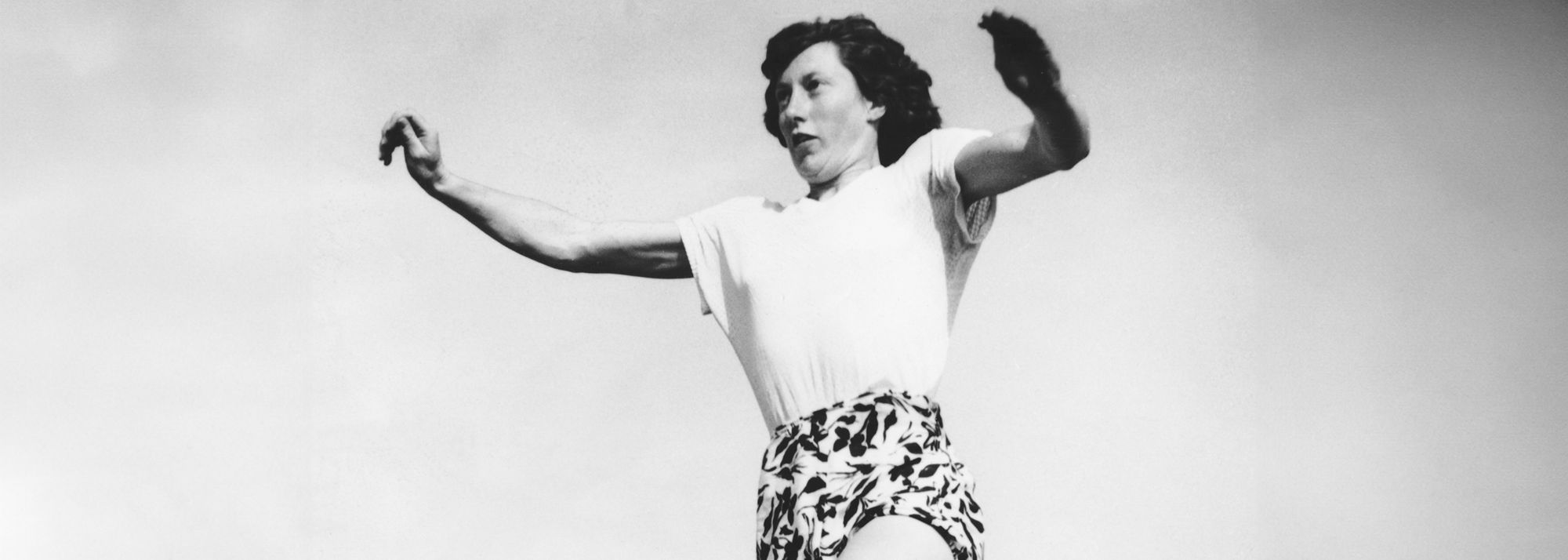New Zealand's Yvette Williams in long jump training at the Helsinki Olympic Games in 1952 (© Getty Images)
Yvette Williams’ mother, Winnie, was the highland dancing champion of New Zealand. Her father, Tom, was a grenade-throwing champion in the Australian Imperial Force on the Western Front in the First World War.
The doting parents were watching proudly from the main stand of the Childers Road Stadium in Gisborne – near the spot where the British explorer Captain James Cook first landed on New Zealand soil – when Yvette exploded off the take-off board and landed herself in track and field’s world record book.
That was 70 years ago today, on 20 February 1954.
Gisborne Athletics Club arranged a meeting with the express intention of helping Tom and Winnie’s multi-gifted daughter to attack the world long jump record that had passed its 10th anniversary the previous September: the 6.25m set by the supreme Dutch all-rounder Francina Blankers-Koen in Leiden back in the mists of 1943.
Yvette had twice come close to Fanny Blankers-Koen’s mark.
At the 1952 Olympic Games in Helsinki, she jumped 6.24m, becoming her country’s first Olympic track and field champion, and the first female New Zealander to win an Olympic gold medal in any sport.
At her national championships in Hamilton earlier that year, she leapt 6.29m but with the assistance of a following wind beyond the allowable two metres per second.
The Gisborne club made arrangements for Williams’ parents to be flown in from Dunedin for the occasion. According to The Gisborne Herald, they also set out “a specially-prepared jumping pit, with two flags on the side – a green one to mark the New Zealand record held by Yvette (6.24m) and a red one for the world record (6.25m).”
4cm beyond the red flag
The local newspaper carried a vivid description of what proved to be the decisive attempt by Williams: “In perfect form, she sailed through the quiet air. After she had landed, it could be seen even from the packed stand – in which her mother and father shared the tenseness of the occasion – that she had landed beyond the far-off red flag.
“Wave after wave of cheering and hand-clapping burst from the spectators. As for the record-breaker herself, her first reflex action was to bound from the pit and leap into the air in exaltation.”
With a mark of 6.29m, Williams had exceeded the red flag, and Blankers-Koen’s world record, by 4cm.
“Mr Williams walked proudly into the arena and embraced his daughter,” the newspaper report continued, “and, as she walked from the track to the stand, she was kissed warmly by her mother.
“No athlete has ever deserved success as Miss Williams deserves hers.”
“I knew I would be able to break it,” Williams herself reflected. “I was only 1cm off it at the Olympics two years ago.”
21 national titles across five events
In an era in which female athletes relied largely on lightly-honed natural talent, the deserving Miss Williams maximised her potential with a work ethic of Trojan proportions.
Born and raised in Dunedin, she played basketball for her country and netball for New Zealand’s South Island.
She joined Otago Athletics Club early in 1947, at the age of 17, and just two months later won the shot put at the New Zealand Championships – the first of 21 national titles across five disciplines: shot, discus, javelin, long jump and 80m hurdles.
Williams trained at the Caledonian Ground in Dunedin, taking her younger brother, Roy, with her, so he could run after the discus and toss it back to her. Her greatest supporter, Roy Williams went on to win decathlon gold for New Zealand at the 1966 Commonwealth Games in Kingston.
Yvette herself made her first mark at the Commonwealth Games – or British Empire Games, as they were known at the time – on home ground in Auckland in 1950. Controversially omitted from the New Zealand team for the 1948 Olympics, she won the long jump with a Commonwealth record of 5.91m and also took silver in the javelin, throwing 37.97m.

Yvette Williams wins the long jump in Auckland in 1950 (© Getty Images)
Bellwood’s harrowing childhood
Yvette was coached at Otago AC by the uncompromising Jim Bellwood.
The victim of regular beatings growing up as a foster child, he slept rough as an odd-jobbing farm worker and spent three years as a Prisoner of War in Greece during the Second World War. He resolved that if he survived the harrowing experience, he would devote his life “to helping to guide the surplus energy of youth into more healthy outlets.”
Bellwood managed to escape at the second attempt and spent time in a rehabilitation hospital in Britain before studying as a physical education instructor at the world-renowned Loughborough College in England’s East Midlands.
After settling back home initially in Dunedin, he used to take Williams to St Clair Beach and get to her leap off the sand dunes. It was there that he taught her to copy the mid-air hitch-kick technique developed by Jesse Owens.
When Bellwood and his Estonian wife Ellie moved to Auckland early in 1952, Williams followed them, boarding with an aunt and uncle and working as a secretary.
Army boots to Olympic success
In the run up to the Helsinki Olympics, she spent an hour before work each morning performing callisthenics and weight training. “My uncle built a sort of gym in the spare room,” she recalled. “I used concrete blocks and sandbags for weights.”
During her lunch break, Williams trained on the hills of the Domain, the vast Auckland park on the site of the Pukekawa volcano. “I ran in army boots for 30 to 45 minutes,” she said.
“The theory was that when I didn’t have the boots on, it would feel like I was flying. It certainly did feel good without them.”
After work, Williams would embark on her third session of the day – three hours of technical jumping and throwing work under the supervision of Bellwood.
All the hard graft paid a golden dividend in Helsinki. Williams jumped an Olympic record of 6.16m in the qualifying round but suffered sprained knee ligaments in the process.
In her first two attempts in the final, she overstepped the take-off board. Facing elimination, she moved her starting marker back four inches and succeeded in landing a valid 5.90m – before nailing the 6.24m effort that earned her historic gold.
The Kiwis in the crowd raced on to the in-field to complete a celebratory haka, the Maori war dance the New Zealand All Blacks rugby union team perform before matches. Then her team-mates carried her from the arena on their shoulders, draped in a New Zealand flag.
“Standing on the top step of the dais, seeing the New Zealand flag go up and hearing our national anthem play…that was the highlight of my athletics career,” Williams reflected.
Simultaneous golds
There was another major high before Williams announced her retirement. At the 1954 Commonwealth Games in Vancouver, she completed a golden hat-trick of long jump, shot put and discus titles.
Remarkably, she competed in the long jump and discus finals simultaneously, changing her shoes six times. She also reached the final of the 80m hurdles, finishing sixth.
After hanging up her spikes, the Kiwi golden girl became a PE teacher and coach as Yvette Corlett, having married Charles ‘Buddy’ Corlett, a Canadian who went on to play basketball and softball for New Zealand.
The family sporting genes filtered down to the Corletts’ children. Neville played basketball for New Zealand. Peter was a New Zealand junior decathlon champion and record-holder and was an All Blacks trialist. Karen was a national rhythmic gymnastics champion.
Yvette Corlett died in April 2019, aged 89. She was hailed as her country’s Athlete of the Century at the Centenary Celebrations for Athletics New Zealand in 1987.
Simon Turnbull for World Athletics Heritage





